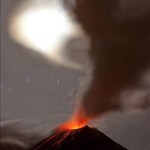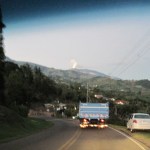Tungurahua
Just a reminder, if you any questions for Sally Kuhn Sennert of the Smithsonian/USGS Global Volcanism Program - about the Weekly Report, about life at the GVP, about volcanoes - be sure to send them to me soon at .
Now, on to this week's update!
Some highlights (not including Gorely):
Lahars from Tungurahua in Ecuador moved blocks upwards of 2 m in diameter downstream over the last week and ash fall was reported over 20 km from the volcano's vent. For some reason, FoxNews decided to use an image of Tungurahua for an article on stats of natural disasters in 2009 - nice image, but the volcano…
The level of news-frenzy on some of the recent volcanic eruptions has died down, but if you're looking to see information on the many rumbling going on worldwide, look no further. Here is this week's Volcanic Activity Report put together by Sally Kuhn Sennert of the Global Volcanism Program.
Highlights - not including Pacaya, Yasur, Tungurahua and our friend in Iceland - include:
The eruption in the Marianas apparently came from South Sarigan volcano - at least according to the best guess by folks who work in the Marianas. This submarine volcano apparently shows evidence of young lava flows…
Tungurahua in Ecuador erupting on May 31, 2010.
Two volcanoes along the edge of the north Pacific had explosive eruptions over the weekend. We have some more details on both of the eruptions, so I'll pass them on:
Bezymianny
KVERT is excited because they claim to have predicted the explosive eruption of Bezymianny almost to the day. They had been closely monitoring the volcano and issued this statement on May 20:
According to satellite data by AVO and KVERT staff, a temperature of
the thermal anomaly over the lava dome of Bezymianny volcano began
increasing from May 19 (from -1 (9:49 UTC) to…
Dark ash covers an American Airline 737 on the tarmac at the airport in Guatemala City.
Two volcanoes are making headlines right now (and neither is in Iceland).
As I mentioned yesterday, Pacaya in Guatemala erupted (video) causing widespread disruption of life in the nearby Guatemala City and costing two people their lives (including a TV reporter who got too close to the vent). Almost 2,000 people have been evacuated from the region near the volcano. The BBC has posted some impressive video of the eruption of Pacaya, showing the strombolian explosions sending basaltic tephra high into the…
Sally Sennert from the Smithsonian Institution sent me an email to say that this week's USGS/Smithsonian Institute Weekly Volcanic Report will be delayed due to the inclement weather in the Washington DC area. She can't connect with the server, so the report can't be updated on the Smithsonian website ... so here it is! Look for it to show up on the Smithsonian site with all the bells and whistles as soon as DC thaws out.
And a big thanks to Sally for sending me the Report to post.
***PLEASE NOTE: Website posting of the SI/USGS Weekly Volcanic Activity Report for 3-9 February 2010 will be…
Tungurahua erupting in an undated AP photo (although I think it is the current 2010 activity.)
It hasn't really made it to much of the English-speaking news, but the current eruptive activity at Tungurahua appears to be on the up-tick. Hugo Yepes of the Geophysical Institute of Ecuador suggests that a larger eruption is not out of the question (link in spanish), but right now the activity is confined to explosions (vulcanian?) and ash fall around the region, specifically on Pillates and Choglontus overnight (2/1) from the ~ 2 km / 5 000 foot plume. Looking at the specifics (link in spanish…
Some news for the last Friday in January:
Volcanic lightning captured over Redoubt in March 2009.
Tungurahua in Ecuador continues to erupt. Yesterday, the volcano spread ash over much of central Ecuador. Apparently people in Ecuador aren't taking the hazard of ash too seriously, with many ignoring recommendations to wear masks when the ash is falling. Over 50 explosions have been recorded over the last 24 hours at the volcano according to the Ecuadorian Instituto GeofÃsico, most of them small to moderate.
We also have a new USGS/Smithsonian Institute Volcano Activity Report. Much of the "…
Somehow I haven't posted a bunch of interesting items collected over the last few weeks, so I need to catch up. A pre-emptive hat tip to everyone who has sent me links or notes that might seem familiar in this post.
Tungurahua in Ecuador erupting in 2000.
First off, those of you looking for information on the Haitian earthquake that devastated the capitol Port Au Prince, Highly Allochthonous has post on the tectonics of the quake. Right now, it is hard for me to come up with a worse location in terms of devastation for a quake to have hit in the Caribbean Basin.
Back in volcano news, a lot…
The steam plume from Turrialba on December 26, 2009. Image by Eruptions reader Sahrye Cohen.
Turrialba
Costa Rican officials extended the evacuation zone around Turrialba from 3 to 6 km, raising the alert status at the volcano to Yellow. Vanessa Rosales of the National Emergency Commission described the seismicity as "intense but low," but says the country is prepared to deal with the emergency. As always, the news chooses oddly what is the "news" of an event, and many article on Turrialba focus on Costa Rica's coffee - yes, it is safe, so far. A news report from the Tico Times quotes Raul…
The slow summer for volcanic eruptions continue. Only 11 updates in this week's USGS/SI report. Thanks again to SI's Sally Kuhn Sennert for compiling the news!
Highlights this week include (not including Kilauea) include:
Tungurahua in Ecuador produced some minor lahars on August 21 to go with steam-and-gas emissions.
Popocatépetl in Mexico produced an ash plume that reached ~8.2 km / 27,000 feet on August 20 and continued to produce steam-and-ash plumes throughout the week following.
Over on the Kamchatka Peninsula, both Koryaksky and Shiveluch produced significant ash plumes (reaching 3-5…
The Q&A post will be coming over the weekend (there's still time to send me a question!)
Icy cold volcanoes (well, geysers) on Enceladus, a moon of Saturn.
In the meantime, here are a few quick hits:
Mt. Cleveland in the Aleutians had a small eruption. The plume was only ~15,000 feet / ~3 km. Cleveland is one of the more active volcanoes in the Aleutians, so this eruption is not out of the norm.
Landslides and rockfalls at Arenal (in spanish) in Costa Rica continue to prompt evacuations of tourists near the volcano. It is interesting to note that officials don't seem worried about hotel…
Busy busy analysing on the multicollector ICP-MS today (but not busy enough to miss this).
Here's your weekly volcano news roundup from the USGS/Smithsonian GVP.
Highlights (not including Sarychev Peak) include:
Continued dome growth and degassing at Bezymianny in Russia. Starting next year, there will be live webcams for three of the major volcanoes (Bezymianny, Kliuchevskoi, and Shiveluch) on the Kamchatka peninsula! Now, that is exciting news.
The glowing coming from the vent in the Halema'uma'u Crater at Kilauea in Hawai'i is still prominent. The lava levels in the crater have been…
A few quick news bits ... and thanks for the questions so far. Keep 'em coming!
Tungurahua, Ecuador erupting in 2006.
Ash fall from Tungurahua (in spanish) in Ecuador is affecting the farm towns around the volcano. Farmers in Manzano, a village nearby, fear the ash is significant enough to damage their crops. The volcano itself is throwing incandescent bombs near the vent along with producing copious ash.
There is a nice piece in the News Tribune about how Alaska Airlines handled the eruption of Mt. Redoubt near Anchorage this March. It is nice to get some insight into how airlines deal…
This week's edition of Wednesday Whatzits could have been called "Miércoles Materia" as all the updates are for South American volcano. Enjoy!
Tungurahua in Ecuador
(Note: all links in spanish)
INGEOMINAS in Colombia is reporting that Nevado del Huila experienced 343 earthquakes over the past week, suggesting that something is brewing at the volcano. This has been accompanied by gas emissions and ash from the fractured dome. The Volcano Observatory in Popayán mentions that more than half of the earthquakes are related to magma moving into the system. Huila remains at Level III (Yellow)…
For those of you looking for real volcanic eruption news (no, there was no "Yellowstone eruption"), here is this week's SI/USGS Volcano Activity Report.
And speaking of April Fools Jokes, this is by far my favorite (mostly by its combination of volcanoes and baseball. How could you go wrong with two of my favorite things - hat tip to Fletcher for finding the article).
Highlights (beyond Redoubt) include:
Earthquakes, tremors and steam at El Reventador in Ecuador
12,000-15,000 foot (4-5 km) steam/ash plumes were spotted at Colima, the Mexican volcano.
A shockwave was felt 10 km away from…
Its been a busy week for volcanoes between the headline capturing Tongan and Alaska eruptions. Catch up on what you might have missed with the latest SI/USGS Weekly Volcano Report (for 3/18-3/24). Highlights (beyond Hunga Tonga Hunga Ha'apai and Redoubt) include:
Galeras, Colombia has settled down a bit
More block-and-ash flows from the two dome complexes growing at Chaiten, Chile
Strombolian eruptions at Mt. Etna, Italy
Plumes of steam and minor ash were reported from Popocatépetl, Mexico
A small lahar was seen at Tungurahua, Ecuador
Ash plumes and incandescent tephra explosions were…
I have a few bits of news about one (of the three) volcanoes erupting in Ecuador. Reports from the Foreign and Commonwealth Office of Ecuador says the volcano is still erupting ash and there is evidence that lava is erupting from the summit vent. Not surprisingly, there is a travel ban on both Reventador and Tungurahua.
Ecuador's Geophysical Institute is reporting that Reventador is currently erupting ash. Apparently, there is no threat to nearby Quito or any pipelines near the volcano. The volcano last erupted in 2007 (although the article incorrectly reports 2002) with small VEI 2 explosions and lava flows. The last major eruption was in 2002, a VEI 4 that spread ash over Quito and caused a number of fatalities. The 2002 eruption was an impressive one (see picture above), producing numerous lahars and a 17-km tall (~55,000 feet) ash column. This also makes two currently erupting volcanoes in Ecuador with…
Admittedly, this is only a brief report, but there are indications that Tungurahua in Ecuador might be heading into a new period of heightened activity. Over the last week or so, there has been increased seismicity, reports of "booming noises" and increased ash emissions from the volcano. Being one of the more active volcanoes in the Andes, it would be surprising if the new eruptions were very big, but instead we might expect more frequent moderate ash and pyroclastic eruptions. However, with this little information, it is hard to tell what might happen and I'll keep my eyes peeled for more…
Not really a "new eruption" as such, but the Geophysics Institute of Ecuador is reporting that Tungurahua, one of the most active volcanoes in South America, has been erupting ash and bombs as of late, along with showing signs of increased seismicity. Nothing new for this tongue-twister of a volcano as it has been erupting since 1999.

